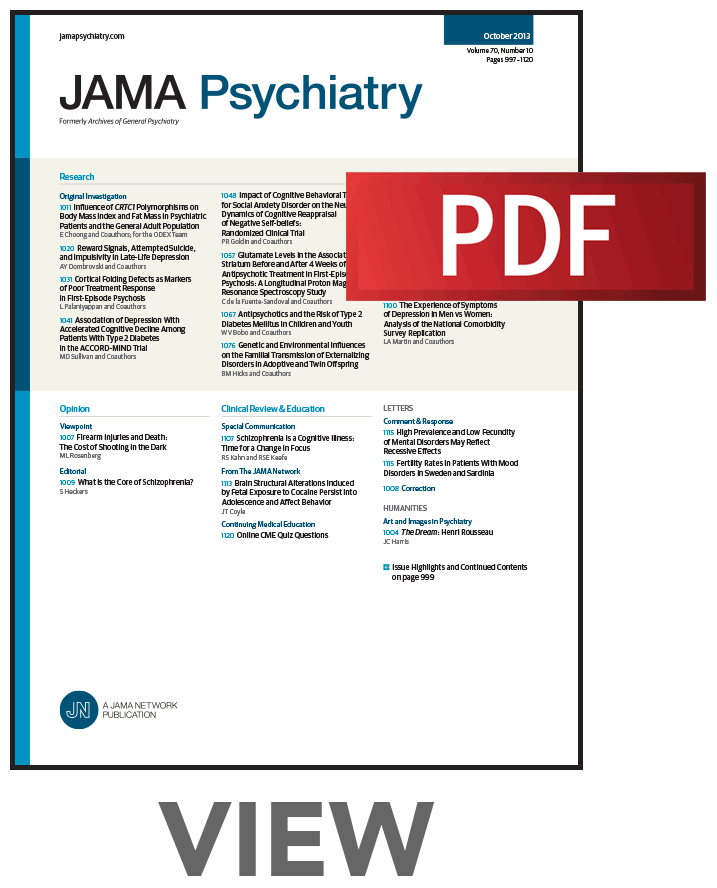Polygenic Risk, Psychopathology, and Personalized Functional Brain Network Topography in Adolescence
IF 17.1
1区 医学
Q1 PSYCHIATRY
引用次数: 0
Abstract
ImportanceFunctional brain networks are associated with both behavior and genetic factors. To uncover biological mechanisms of psychopathology, it is critical to define how the spatial organization of these networks relates to genetic risk during development.ObjectiveTo determine the associations among transdiagnostic polygenic risk scores (PRSs), personalized functional brain networks (PFNs), and overall psychopathology (p-factor) during early adolescence.Design, Setting, and ParticipantsThe Adolescent Brain Cognitive Development (ABCD) Study is an ongoing longitudinal cohort study of 21 collection sites across the US. This cross-sectional analysis includes ABCD baseline data collected between September 2016 and October 2018. The ABCD Study is a multisite community-based study. The sample is largely recruited through school systems. ABCD exclusion criteria included severe sensory, intellectual, medical, or neurological issues that interfere with protocol and scanner contraindications. Split-half subsets were used for cross-validation, matched on age, ethnicity, family structure, handedness, parental education, site, sex, and anesthesia exposure. Data were analyzed from January 2023 to July 2024.ExposuresPolygenic risk scores of transdiagnostic genetic factors F1 (PRS-F1) and F2 (PRS-F2) derived from adults in Psychiatric Genomic Consortium and UK Biobanks datasets. PRS-F1 indexes liability for common psychiatric symptoms and disorders related to mood disturbance; PRS-F2 indexes liability for rarer forms of mental illness characterized by mania and psychosis.Main Outcomes and MeasuresP-factor derived from bifactor models of youth- and parent-reported mental health assessments and person-specific functional brain network topography derived from functional magnetic resonance imaging scans.ResultsTotal participants included 11 873 children aged 9 to 10 years; 5678 (47.8%) were female, and the mean (SD) age was 9.92 (0.62) years. PFN topography was found to be heritable (imaging subsample, n = 7459; 57.1% of vertices: mean青少年的多基因风险、精神病理学和个性化功能脑网络地形
重要功能脑网络与行为和遗传因素都有关联。为了揭示精神病理学的生物学机制,确定这些网络的空间组织如何与发育过程中的遗传风险相关是至关重要的。目的探讨青春期早期跨诊断多基因风险评分(PRSs)、个性化脑功能网络(pfn)和整体精神病理(p因子)之间的关系。设计、环境和参与者青少年大脑认知发展(ABCD)研究是一项正在进行的纵向队列研究,在美国的21个收集点进行。该横断面分析包括2016年9月至2018年10月收集的ABCD基线数据。ABCD研究是一项多地点社区研究。样本主要是通过学校系统招募的。ABCD排除标准包括严重的感觉、智力、医学或神经问题,这些问题干扰了协议和扫描仪禁忌症。分半亚组用于交叉验证,匹配年龄、种族、家庭结构、惯用手、父母教育程度、地点、性别和麻醉暴露。数据分析时间为2023年1月至2024年7月。来自成人的跨诊断遗传因子F1 (PRS-F1)和F2 (PRS-F2)的多基因风险评分,来自Psychiatric Genomic Consortium和UK biobank数据集。PRS-F1指标与情绪障碍相关的常见精神症状和障碍的倾向性;PRS-F2指标对以躁狂症和精神病为特征的罕见精神疾病的倾向性。主要结果和测量方法:青少年和父母报告的心理健康评估的双因素模型衍生的因素和功能性磁共振成像扫描衍生的个人特异性功能性脑网络地形。结果共纳入9 ~ 10岁儿童11873人;女性5678例(47.8%),平均(SD)年龄为9.92(0.62)岁。发现PFN地形具有遗传性(成像亚样本,n = 7459;57.1%的顶点:平均h2, 0.35;错误发现率修正P &;. 05)。PRS-F1与p因子相关(欧洲血统亚样本,n = 5815;r, 0.12;95% ci, 0.09-0.15;P, amp;肝移植;措施)。功能网络地形的个体间差异与p因子相关(成像子样本,n = 7459;平均r为0.12),PRS-F1(成像和欧洲血统亚样本,n = 3982;平均r, 0.05), PRS-F2 (n = 3982;平均r, 0.08)。p因子皮质图与PRS-F1回归系数相关(r, 0.70;P = 0.003,排列检验,N = 1000)。结论和相关性在这项研究中,青春期早期跨诊断成年精神病理的多基因风险与p因子和遗传性PFN地形有关。这些结果可能会促进我们对精神病理学发展驱动因素的理解。
本文章由计算机程序翻译,如有差异,请以英文原文为准。
求助全文
约1分钟内获得全文
求助全文
来源期刊

JAMA Psychiatry
PSYCHIATRY-
CiteScore
30.60
自引率
1.90%
发文量
233
期刊介绍:
JAMA Psychiatry is a global, peer-reviewed journal catering to clinicians, scholars, and research scientists in psychiatry, mental health, behavioral science, and related fields. The Archives of Neurology & Psychiatry originated in 1919, splitting into two journals in 1959: Archives of Neurology and Archives of General Psychiatry. In 2013, these evolved into JAMA Neurology and JAMA Psychiatry, respectively. JAMA Psychiatry is affiliated with the JAMA Network, a group of peer-reviewed medical and specialty publications.
 求助内容:
求助内容: 应助结果提醒方式:
应助结果提醒方式:


